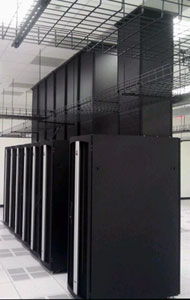A data center professional recently asked Ian Seaton, Chatsworth Products’ (CPI) Global Technology Manager, the following question:
“We are in the design phase of our new data center, and are planning to go with a raised floor for air distribution and utilize cabinets with vertical exhaust ducts (VEDs) for hot/cold separation. I need to work out the actual elevations for ladder rack and power-distribution bus above the cabinets, but I was wondering if there is an optimum VED height that works best.
“I know the VED comes in two basic sizes, both having a low and high adjustable heights. Given the option that we could use either size model, is there a VED height that works better than others for heat evacuation? Is there an optimum height or ratio that heat models better than others? We will most likely use 45U cabinets, 1200mm depth and various widths.”
Answer:
 Theoretically, if we look at the terms in the Darcy-Weisbach equation for calculating pressure drop or head pressure on a duct, the shorter the VED the better. However, in practical terms, there is no way you can cram enough load into a cabinet to challenge any thresholds within the limits of the standard product offering.
Theoretically, if we look at the terms in the Darcy-Weisbach equation for calculating pressure drop or head pressure on a duct, the shorter the VED the better. However, in practical terms, there is no way you can cram enough load into a cabinet to challenge any thresholds within the limits of the standard product offering.
Therefore, you need to find that perfect balance for your own application environment that gives you the maximum volume of space for return air above the suspended ceiling, while giving you adequate room to deploy and manage whatever you plan to put between the cabinet and the ceiling – cable pathway, fiber troughs, power busway.
In other words, the VED should be as short as you can get it, while meeting all of your associated space requirements. The driver for that is not maximizing the airflow through the VED, but maximizing the space above the VED. If the space above the ceiling is already disproportionately large, then you have the luxury of basing your decision on access and aesthetics.
I hope this helps.
Ian Seaton
Seaton recently wrote “Extend the Life of Your Data Center,” which details how it’s possible to rescue lost power and cooling with containment. Read all about his findings here.
Raissa Carey, eContent Specialist